A Story of Oseonbo: Sounds Lost in Translation
2022
Single-channel video, stereo sound
47 minutes 8 seconds
This work examines a musical score created during Korea’s modernization period, a time marked by the influx of foreign cultures and the frequent erosion or transformation of traditional practices.
Joseon Guak Yeongsan Hoesang is a score transcribed in 1914 by Insik Kim, a teacher at the Joseon Court Music Study Institute, who translated the yanggeum (Korean dulcimer) score for the piece Yeongsan Hoesang into Western staff notation. Featuring gueum (a form of oral notation or symbols used in place of musical notes to mimic instrument sounds) written in Korean language, the score is the earliest known example of Korea’s old notations being adapted into the Western notation system by a Korean. Musicians at the time compiled scores on staff notation in an effort to introduce traditional Korean music to the outside world or to incorporate foreign sensibilities into Korean musical compositions. However, at the same time, there were also sounds and techniques in traditional music that could not be adequately conveyed through Western staff notation.
Centered mainly on interviews with traditional music performers, composers, and researchers, the work reconstructs their various speculations on the sounds and sentiments in the score that have been lost or transformed in the process of translation. By combining archival materials and ordinary video footage, the work also investigates the colonial history of music education and contemporary musicians’ ambivalence toward what has remained through this educational legacy. In doing so, it raises questions about the institutionalization of staff notation and other forms of musical systems that have become entrenched as contemporary musical frameworks, while reflecting on today’s traditional music.
Adapted commission by the 15th Gwangju Biennale in 2024
(KR)
2022
Single-channel video, stereo sound
47 minutes 8 seconds
This work examines a musical score created during Korea’s modernization period, a time marked by the influx of foreign cultures and the frequent erosion or transformation of traditional practices.
Joseon Guak Yeongsan Hoesang is a score transcribed in 1914 by Insik Kim, a teacher at the Joseon Court Music Study Institute, who translated the yanggeum (Korean dulcimer) score for the piece Yeongsan Hoesang into Western staff notation. Featuring gueum (a form of oral notation or symbols used in place of musical notes to mimic instrument sounds) written in Korean language, the score is the earliest known example of Korea’s old notations being adapted into the Western notation system by a Korean. Musicians at the time compiled scores on staff notation in an effort to introduce traditional Korean music to the outside world or to incorporate foreign sensibilities into Korean musical compositions. However, at the same time, there were also sounds and techniques in traditional music that could not be adequately conveyed through Western staff notation.
Centered mainly on interviews with traditional music performers, composers, and researchers, the work reconstructs their various speculations on the sounds and sentiments in the score that have been lost or transformed in the process of translation. By combining archival materials and ordinary video footage, the work also investigates the colonial history of music education and contemporary musicians’ ambivalence toward what has remained through this educational legacy. In doing so, it raises questions about the institutionalization of staff notation and other forms of musical systems that have become entrenched as contemporary musical frameworks, while reflecting on today’s traditional music.
Adapted commission by the 15th Gwangju Biennale in 2024
(KR)



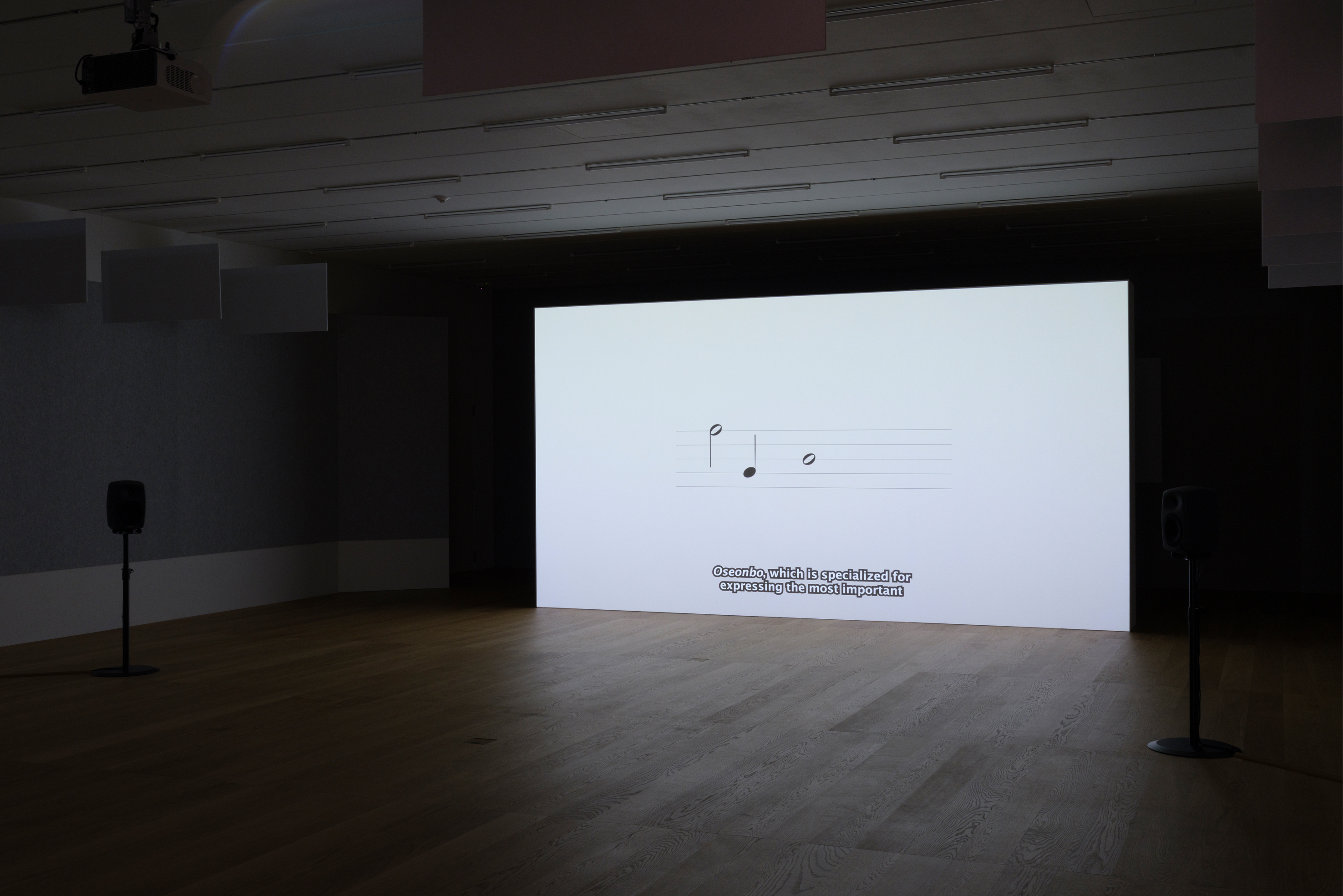
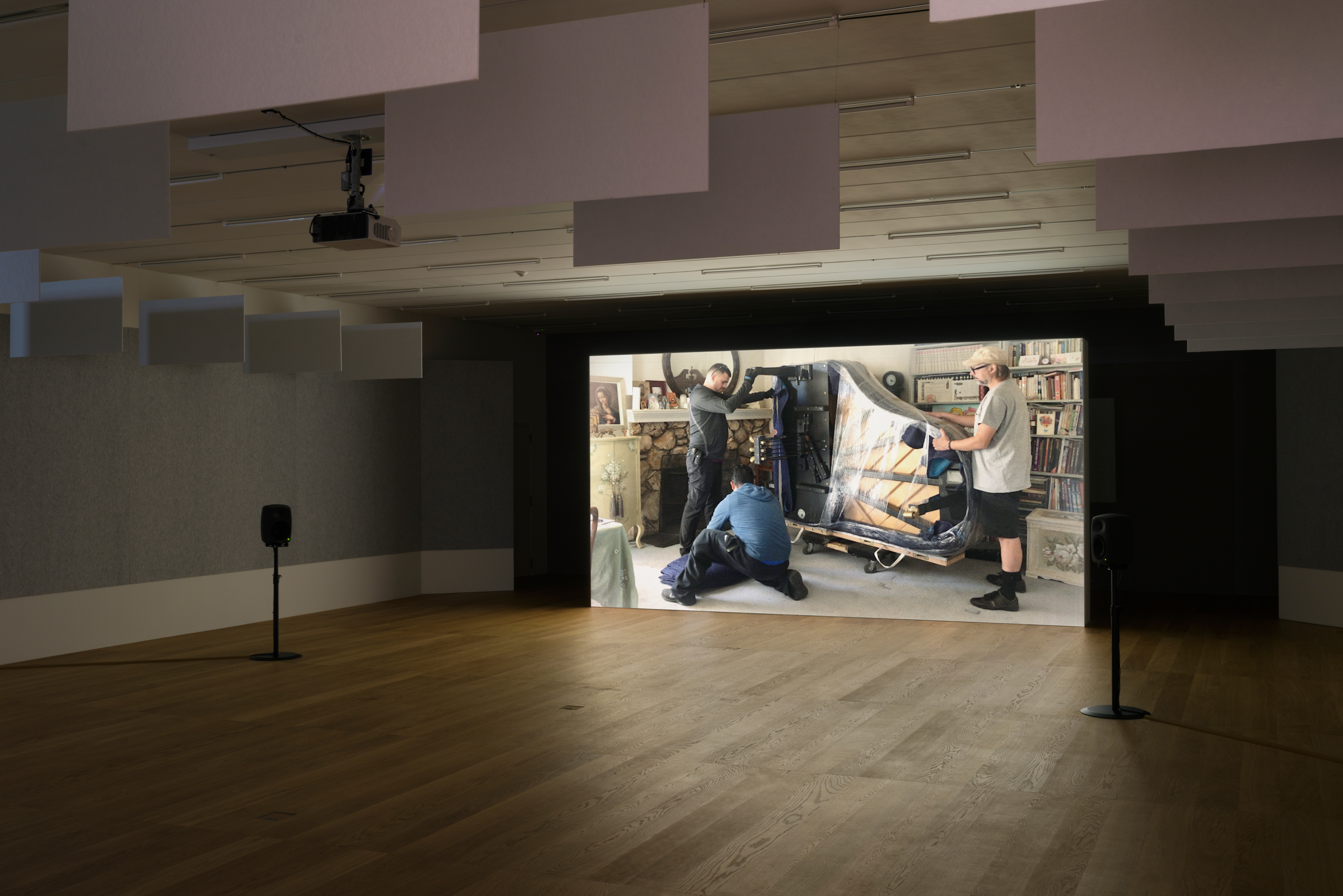




#1-2 Exhibition view, 15th Gwangju Biennale, 2024. Image courtesy of Gwangju Biennale Foundation (Photo by Studio Possiblezone)
#3-5 Installation view at SONGEUN, Seoul (Photo by Jihyun Jung)
#6-9 Still cut
2 min video excerpt
Ear Training
2022
Single-channel video, stereo & binaural sound
15 minutes
Ear training is an exercise aimed at identifying the pitch of a sound played on the piano, and it is a training that develops the ability to accurately perceive pitch, an element considered most important in Western music. As part of Western music education, this training evolved into a form of military training during the Sino-Japanese War, where soldiers honed their ability to identify the sounds of airplanes or detect submarine sounds. This adaptation was based on the logic that if one could internalize pitch through musical sounds, they could also recognize other sounds that correspond to the same pitch, such as the pitch of mechanical noises, even when their timbre differed.
This work reconstructs the ear training that took place in Japanese classrooms and military units during World War II. The ear training is reenacted by drawing on original scores written by students and soldiers who participated in the training, along with interview materials, archival recordings, and scholarly research on this period. The video includes the collection of sounds of enemy airplanes produced by the Army Anti-Aircraft School, underwater sounds analyzed by the Navy, and scenes of ear training tests, all presented from the perspective of a first-person narrator who recounts the auditory experiences of such. This work evokes the forgotten auditory world of a time when all things and senses subordinated to militaristic goals and when the “musical ear” was regarded as a form of munition.
(KR)
*This video features binaural audio recordings. For the best listening experience, listen with headphones.
2022
Single-channel video, stereo & binaural sound
15 minutes
Ear training is an exercise aimed at identifying the pitch of a sound played on the piano, and it is a training that develops the ability to accurately perceive pitch, an element considered most important in Western music. As part of Western music education, this training evolved into a form of military training during the Sino-Japanese War, where soldiers honed their ability to identify the sounds of airplanes or detect submarine sounds. This adaptation was based on the logic that if one could internalize pitch through musical sounds, they could also recognize other sounds that correspond to the same pitch, such as the pitch of mechanical noises, even when their timbre differed.
This work reconstructs the ear training that took place in Japanese classrooms and military units during World War II. The ear training is reenacted by drawing on original scores written by students and soldiers who participated in the training, along with interview materials, archival recordings, and scholarly research on this period. The video includes the collection of sounds of enemy airplanes produced by the Army Anti-Aircraft School, underwater sounds analyzed by the Navy, and scenes of ear training tests, all presented from the perspective of a first-person narrator who recounts the auditory experiences of such. This work evokes the forgotten auditory world of a time when all things and senses subordinated to militaristic goals and when the “musical ear” was regarded as a form of munition.
(KR)
*This video features binaural audio recordings. For the best listening experience, listen with headphones.
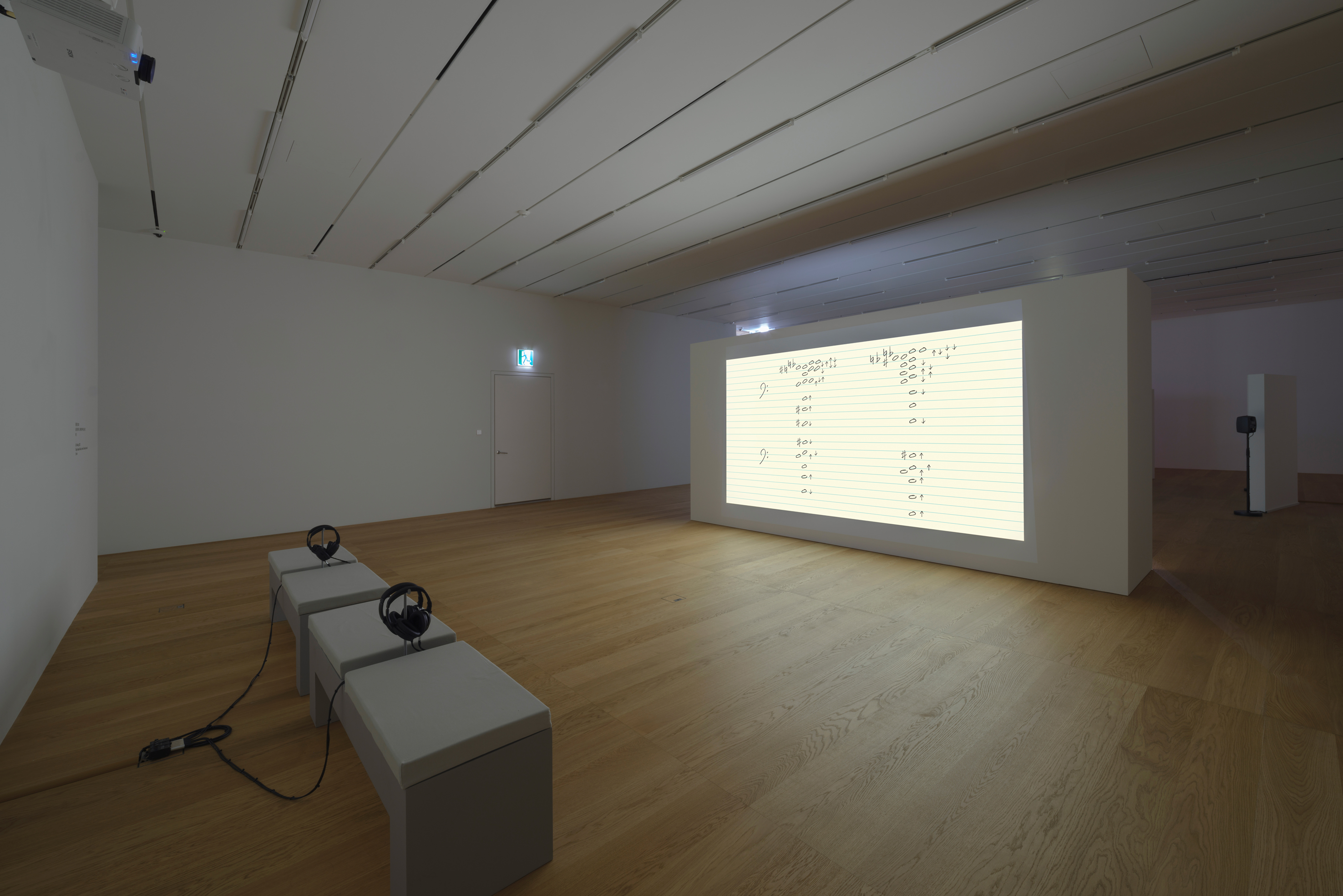
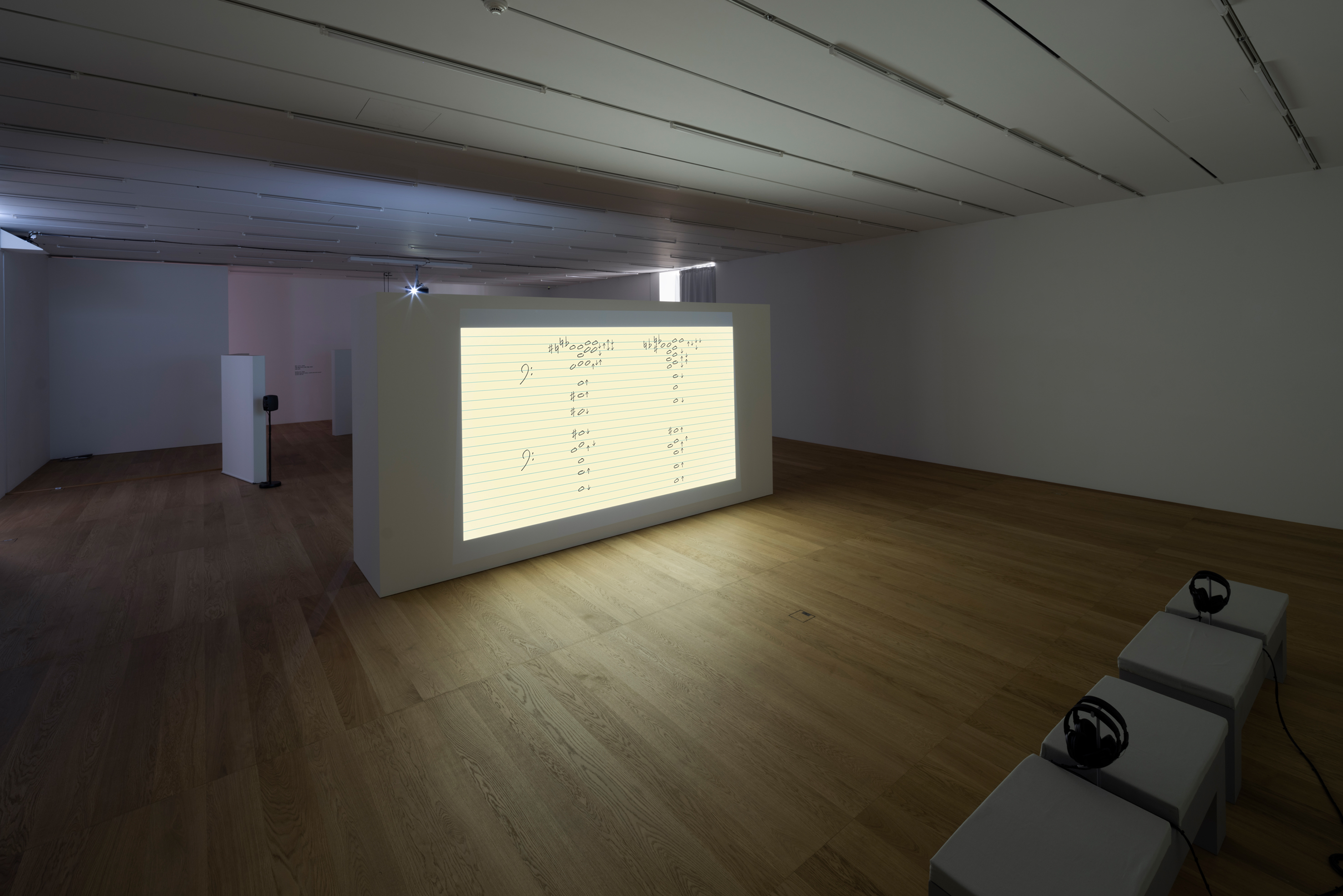



#1-2 Installation View at SONGEUN, Seoul (Photo by Jihyun Jung)
#3-5 Still cut
1 min video excerpt
Brilliant A
2022
Single-channel video, stereo or multi-channel sound
16 minutes 56 seconds
This work delves into the history of how the pitch “A,” used as the standard for tuning most modern instruments in orchestras and other musical contexts, became fixed at a frequency of 440 Hz. It also examines how the pitch has been set continually upwards over time, driven by human auditory preferences for “brighter” sounds. Apparent influences include the competition among instrument makers, who sought to capitalize on the demand for such sounds, as well as the practice of military bands in Europe and the United States, which aimed to send sound over long distances to boost troop’s morale. The work further reconstructs the speculative moment when the standard pitch A was introduced to Korea. The delivery process of a piano is recreated based on historical materials from the early 20th century, which document the arrival of the first piano in the city of Daegu, brought by an American missionary.
The introduction of the piano marked a pivotal shift in the theories and aesthetics of sound instilled in Koreans’ aural perceptions at the time, sparking a series of acoustic collisions that arose as the ear for traditional music gave way to the ear attuned to Western sounds. Through this reconstruction, the work explores the symbolic significance of the Western piano that brought the pitch “A” into Korean society.
Winner of the Korean Shorts Award at the 2023 Jecheon International Music & Film Festival
(KR)
2022
Single-channel video, stereo or multi-channel sound
16 minutes 56 seconds
This work delves into the history of how the pitch “A,” used as the standard for tuning most modern instruments in orchestras and other musical contexts, became fixed at a frequency of 440 Hz. It also examines how the pitch has been set continually upwards over time, driven by human auditory preferences for “brighter” sounds. Apparent influences include the competition among instrument makers, who sought to capitalize on the demand for such sounds, as well as the practice of military bands in Europe and the United States, which aimed to send sound over long distances to boost troop’s morale. The work further reconstructs the speculative moment when the standard pitch A was introduced to Korea. The delivery process of a piano is recreated based on historical materials from the early 20th century, which document the arrival of the first piano in the city of Daegu, brought by an American missionary.
The introduction of the piano marked a pivotal shift in the theories and aesthetics of sound instilled in Koreans’ aural perceptions at the time, sparking a series of acoustic collisions that arose as the ear for traditional music gave way to the ear attuned to Western sounds. Through this reconstruction, the work explores the symbolic significance of the Western piano that brought the pitch “A” into Korean society.
Winner of the Korean Shorts Award at the 2023 Jecheon International Music & Film Festival
(KR)


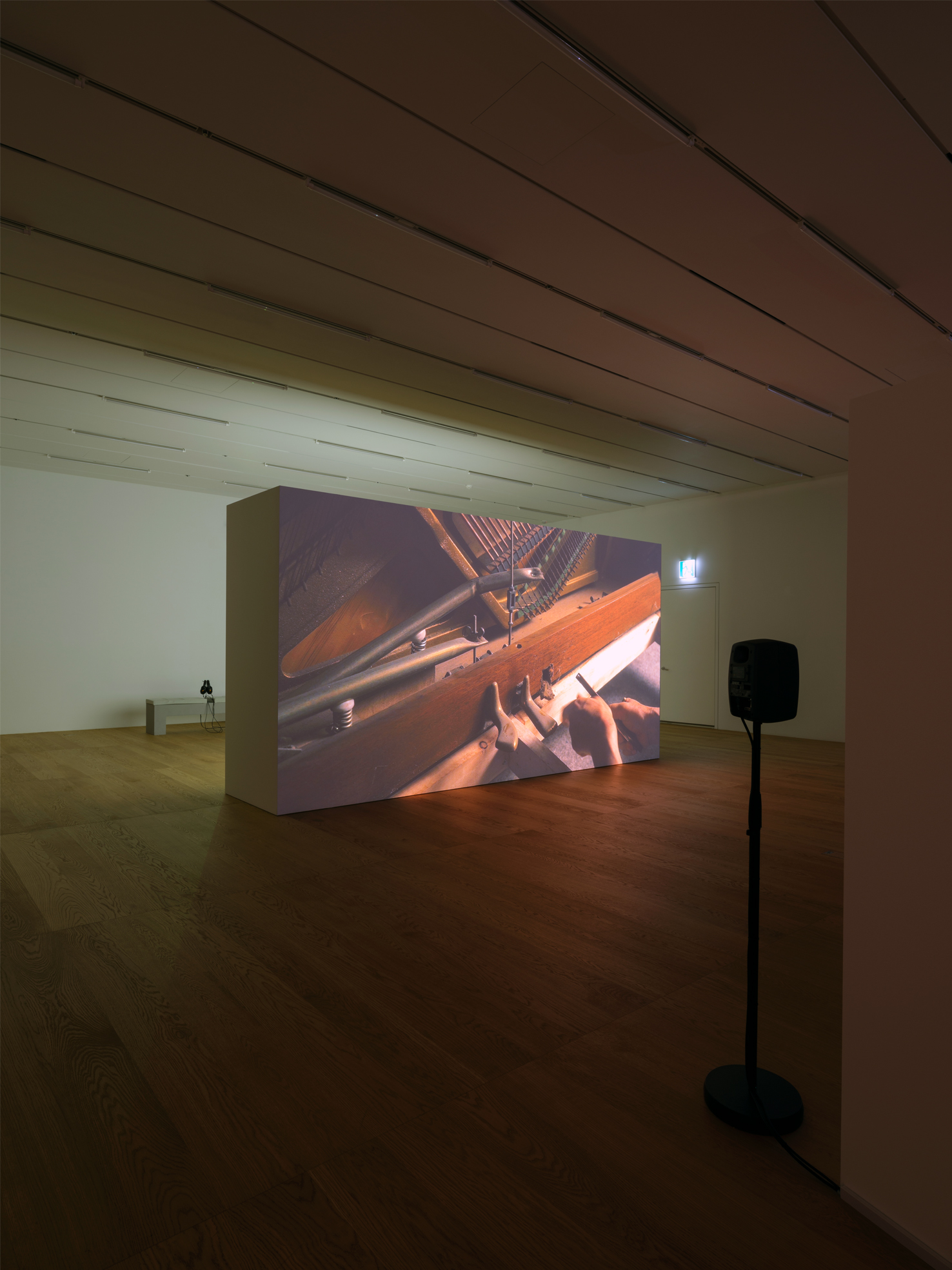

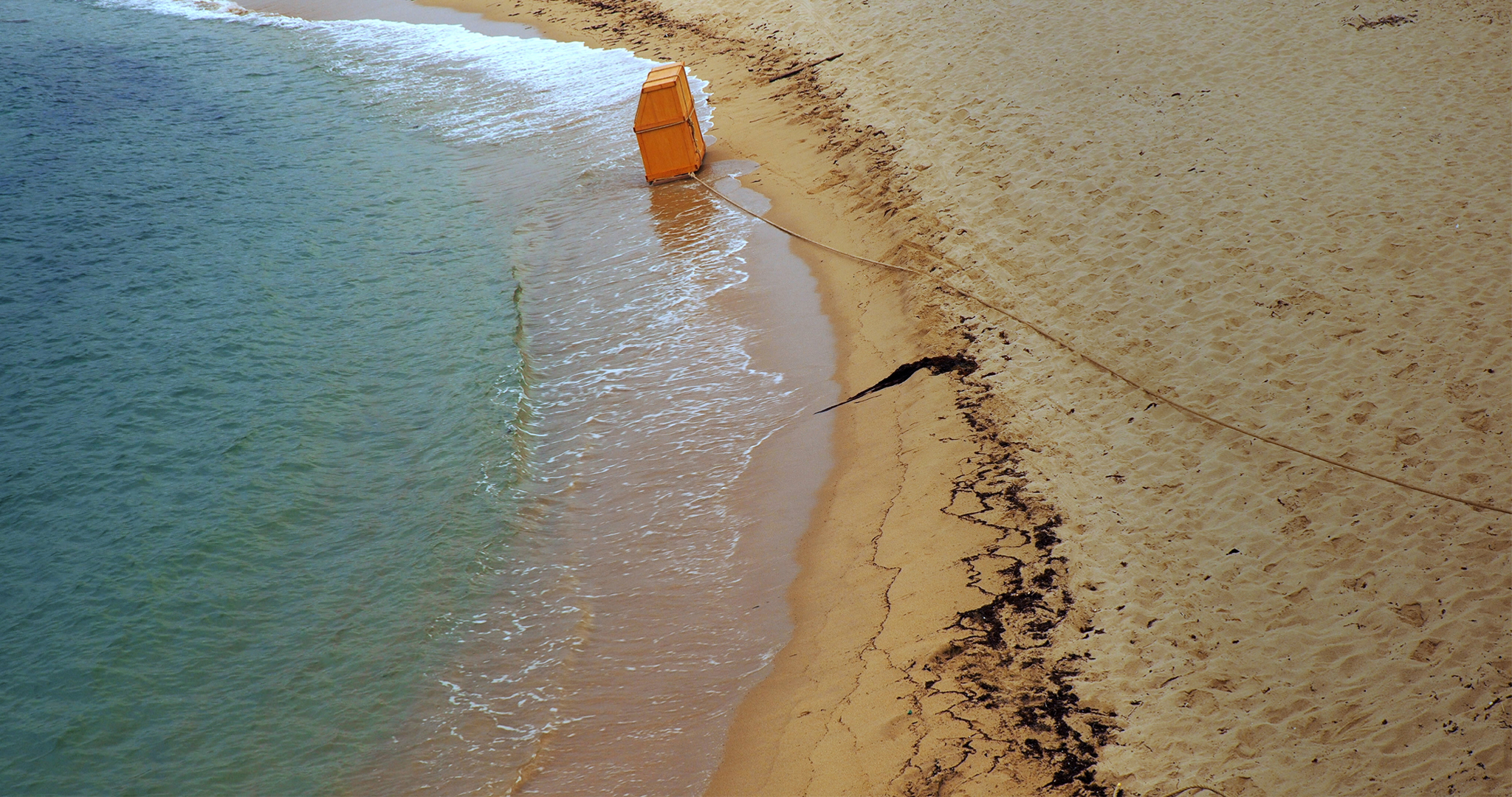



#1-3 Installation View at SONGEUN, Seoul (Photo by Jihyun Jung)
#4-8 Still cut
1 min video excerpt
To Future Listeners I
2022
Single-channel video, stereo sound
8 minutes
This work is a digital performance video that traces the sounds of the past. The narrative unfolds through a contemplation of the ethnographic recordings produced by American anthropologists in the late 19th century, who used phonographs to record the music and language of endangered indigenous peoples. The song featured in the video is Love Song: Ar-ra-rang 1, recorded on a wax cylinder in 1896 by American anthropologist Alice Fletcher, who requested its performance from three Korean students studying in Washington, D.C. This was apparently the first example in the history of Korean traditional music captured on a recording medium.
Wax cylinders are fragile and sensitive to environmental conditions, and thus, the sounds recorded on its wax surface gradually deteriorate into noise over time. In the video, I make repeated use of a noise reduction plugin to reduce the noise in the song while gradually progressing toward the past. The process aims to make the song clearer, but as the software interprets the entire song as noise, the sound becomes increasingly fragmented in an acoustic sense.
The narration in the video is adapted from excerpts of an essay by Sound Studies scholar Jonathan Sterne.
(KR)
2022
Single-channel video, stereo sound
8 minutes
This work is a digital performance video that traces the sounds of the past. The narrative unfolds through a contemplation of the ethnographic recordings produced by American anthropologists in the late 19th century, who used phonographs to record the music and language of endangered indigenous peoples. The song featured in the video is Love Song: Ar-ra-rang 1, recorded on a wax cylinder in 1896 by American anthropologist Alice Fletcher, who requested its performance from three Korean students studying in Washington, D.C. This was apparently the first example in the history of Korean traditional music captured on a recording medium.
Wax cylinders are fragile and sensitive to environmental conditions, and thus, the sounds recorded on its wax surface gradually deteriorate into noise over time. In the video, I make repeated use of a noise reduction plugin to reduce the noise in the song while gradually progressing toward the past. The process aims to make the song clearer, but as the software interprets the entire song as noise, the sound becomes increasingly fragmented in an acoustic sense.
The narration in the video is adapted from excerpts of an essay by Sound Studies scholar Jonathan Sterne.
(KR)




#1 Installation view at SONGEUN, Seoul (Photo by Jihyun Jung)
#2-4 Still cut
1 min video excerpt
To Future Listeners II
2022
Phonograph, wax cylinder
1 minutes 40 seconds
Dimensions variable
A phonograph produced in the 1900s occupies a corner of the exhibition space. The sound coming from this phonograph is A-ra-rang 1, re-recorded onto a wax cylinder with my voice. This piece, at the present point, reiterates the manner in which ethnographic recordings devolve into noise, thereby extending their validity. Through this, I seek to mitigate the deathly connotations that have come to cast over ethnographic recordings.
(KR)
2022
Phonograph, wax cylinder
1 minutes 40 seconds
Dimensions variable
A phonograph produced in the 1900s occupies a corner of the exhibition space. The sound coming from this phonograph is A-ra-rang 1, re-recorded onto a wax cylinder with my voice. This piece, at the present point, reiterates the manner in which ethnographic recordings devolve into noise, thereby extending their validity. Through this, I seek to mitigate the deathly connotations that have come to cast over ethnographic recordings.
(KR)


#1-2 Installation View at SONGEUN, Seoul (Photo by Jihyun Jung)